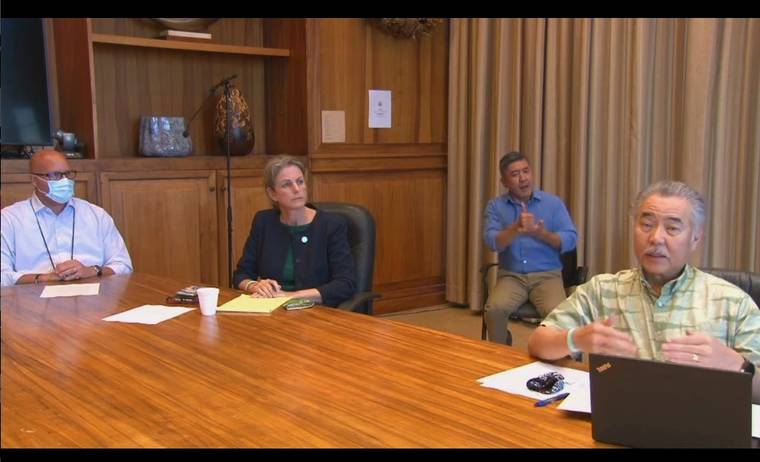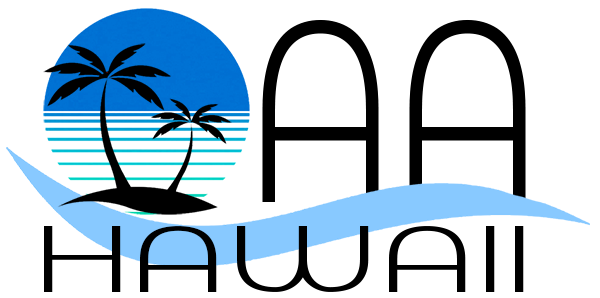By Nancy Cook Lauer West Hawaii Today ncook-lauer@westhawaiitoday.com | Sunday, July 19, 2020, 12:05 a.m.
-

Screen grab of Facebook live session with Paul Jones, Deputy Chief for the Department of the Attorney General Investigations Division, left, with Attorney General Clare Connors and Gov. David Ige, July 16, 2020.
The state isn’t ready to reopen to tourists Sept. 1 and it’s not ready to bring out-of-state college students back to campus Aug. 24, Mayor Harry Kim said in an hour-long interview Thursday.
Kim, who spent decades in Civil Defense, including years at its helm, said his operational experience has taught him to locate the weak links in any procedural chain. If one link fails, the whole operation is likely to fail, he said.
Plans to use a combination of preflight testing with 14-day quarantines for those who aren’t tested or who test positive, simply aren’t feasible without a way of differentiating between the two groups and properly monitoring the quarantiners, Kim said.
The state wasn’t ready to do that Aug. 1, its first planned reopening, and it won’t be ready Sept. 1 either, Kim said. He said he’d urged the governor and his fellow mayors to not attach a date on reopening, but to wait until the state is ready, especially with the “explosive” situation of double-digit increases in cases and deaths on the mainland.
“The mission is to protect the people of the state of Hawaii. The system is not ready,” Kim said. “I know I stand alone. But the risk to me is just not acceptable.”
Kim has often been the odd man out in discussions with the mayors and governor.
“We are on the threshold of major decision-making. I wish I was wrong. I just don’t feel comfortable with where we’re at right now,” Kim said. “The governor has been informed of that.”
But he’s also been on the leading edge of responding to the coronavirus pandemic.
Kim issued an emergency proclamation in February, days before the governor or other mayors. He set up a multi-agency, public-private task force in March, which is now being emulated at the state level. He created a travelers’ database that’s now being replaced by one the state created.
Hawaii Island is by far the most successful recently tracking down and arresting quarantine breakers. From July 13 to 16, Hawaii County arrested 99 people, compared to just 21 on Oahu, where most tourists debark. Kauai County arrested 46 and Maui 16 during that same period.
Attorney General Clare Connors, in a Thursday Facebook live session with Gov. David Ige and Paul Jones, deputy chief for the Department of the Attorney General Investigations Division, defended her agency’s enforcement of the 14-day trans-Pacific traveler quarantine.
The team calling quarantined visitors is made up of workers from the Hawaii Tourism Authority, the Hawaii Visitors and Convention Bureau, Hawaii County Civil Defense and the Maui Police Department. There are approximately 80 members on this calling team, and they work to call quarantined visitors from 9 a.m. to 8 p.m. every day, including weekends and holidays. They have contacted well over 27,000 travelers and have made more than 113,000 phone calls, texts and emails since the quarantine order went into effect at the end of March, a press release stated.
“Enforcement of the quarantine is always going to be a challenge. We know that this is something that is new to our law enforcement community. It’s a very stressful time in the state of Hawaii in general,” Connors said during the Facebook live event. “And so, the idea that we have persons who are subject to quarantine and possibly breaking quarantine causes a lot of stress. But what I do want to reassure people is that we are aware of the need to enforce. And we have set up systems to enforce not just at the airports so that when people come through, they are appropriately screened, they sign orders that they are made aware of the fact that they are subject to these orders, and that it’s for the safety of our community.”
Many of the public watching the feed were skeptical.
“Quarantine does not work. Honor system does not work,” said Sarina Wong. “People either break quarantine or have company while their quarantining! Got to figure out something!”
Gigi Mano agreed.
“We’re making the sacrifices while you’re allowing visitors to continue to fly in with no enforcement whatsoever!!!,” she wrote.
A new modified plan will allow students on two islands to participate in campus activities even while they’re in 14-day quarantine, provided they test negative and meet other health requirements.
Students attending college at campuses on Oahu and Kauai will be allowed the modified quarantine, under plans currently in the works. Kim and Maui Mayor Mike Victorino weren’t supporting the plan, so those islands aren’t reopening as quickly to students. Kim said about half of university of Hawaii at Hilo students come from Texas, Nevada and California, the states with some of the highest COVID-19 hotspots.

